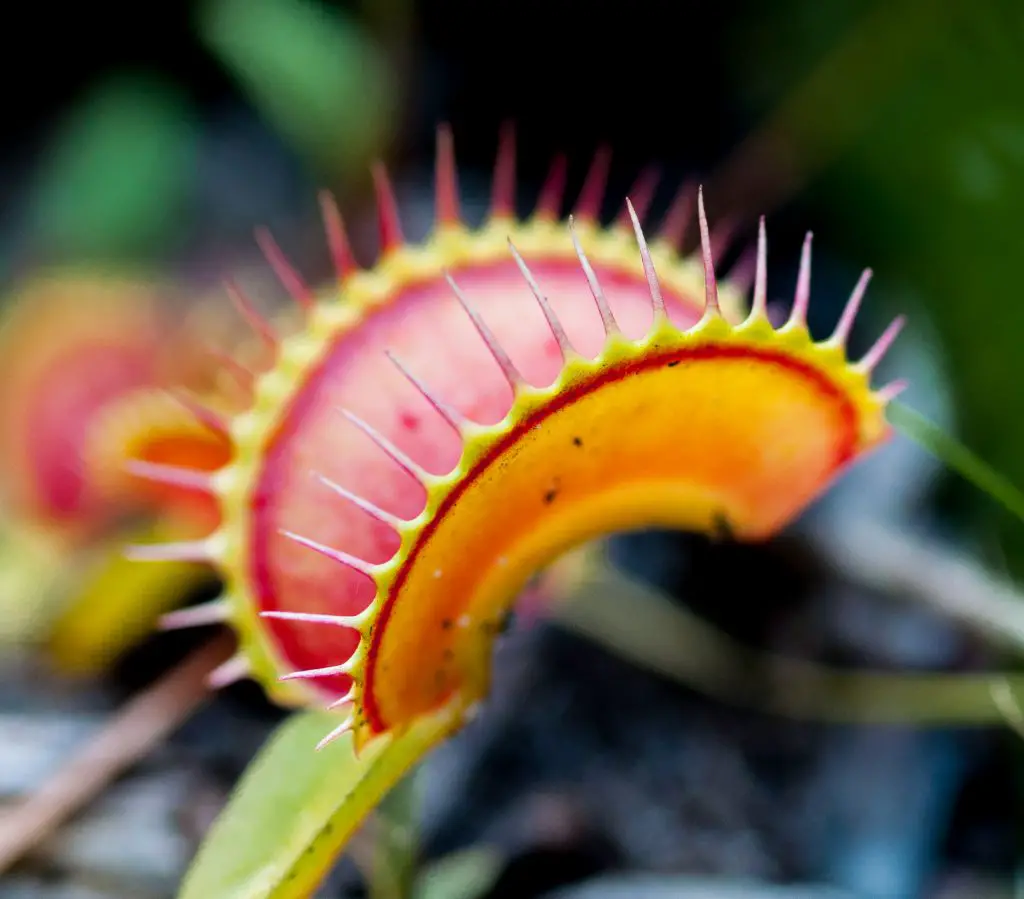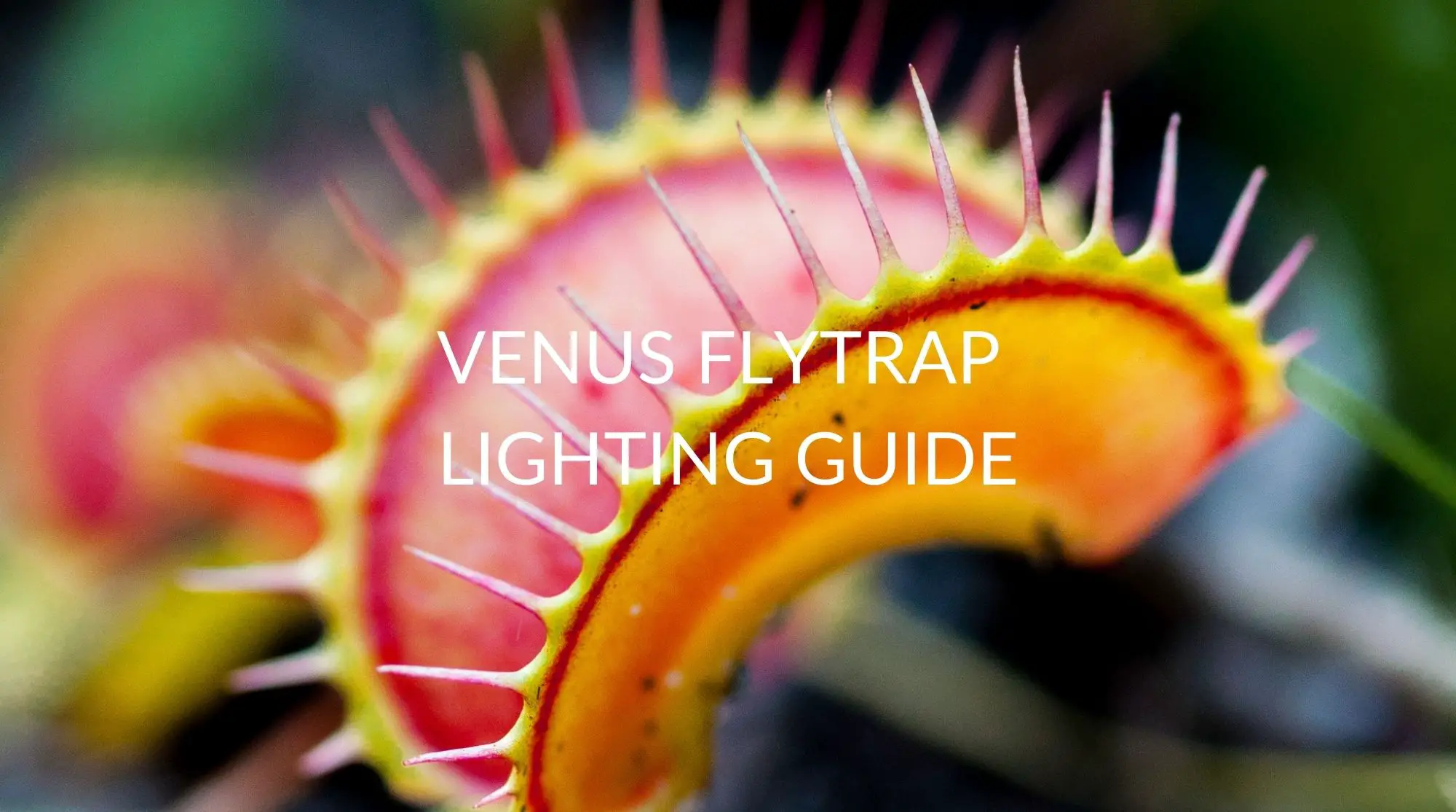The beautiful and intriguing Venus Flytrap is one of the most particular, finicky, and high-maintenance plants to care for. This is especially true when it comes to lighting, climate, and temperature. It likes warmth but not too hot. It enjoys humid, boggy conditions, but the heat will kill it.
The trick is in the lighting, and this guide will lay it all out for you. While a Venus Flytrap thrives well in USDA hardiness zones between 5 and 8, it’s essential it receives at least six to 10 hours of direct sunlight each day. However, if humidity is high in your area or if dry heat is prevalent, it will cause the plant to struggle.
Remember, it’s not about too much light; it’s all about the general environmental temperature. Excessive heat is intolerable. Therefore, caring for a Venus Flytrap indoors with artificial light has its benefits. You can control the temperature while giving the plant plenty of light.
What Kind Of Lighting Do Venus Flytraps Need?
Venus Flytraps are rather picky about their lighting requirements. They need the kind of lighting that’s full spectrum and fairly warm, focusing on a range of blue-violet. They can sit outside up to a balmy 90°F. Anything above 100°F will dry out the plant, and this can result in wilting.
Indoors, they can handle light for longer periods of time when using a grow lamp that contains fluorescent or LED bulbs. In this situation, you can let them sit for as long as 16 hours. In fact, the more light they get, the better and stronger the plant will be.
However, if you plan to use artificial lighting, you want to avoid any bulbs that indicate “watt equivalent.” This is because it may not give off the right amount of lumens the Venus Flytrap requires.
How Much Light Does A Venus Flytrap Need?
Venus Flytraps need about 10 to 14 hours of light per day. However, it depends on if it’s inside or outdoors. If outside, four to six of them should be direct, while the remaining time should be indirect in the shade. The absolute minimum is six hours. But, you want to avoid the bare minimum on a daily basis.
That said, if all it gets is six hours once in a while, it will be fine, but you should really aim for a lot more to ensure its health and to avoid diseases or pests. If you are keeping the plant outdoors, pay attention to the temperature and gauge the number of hours in comparison to the heat.
For instance, if it’s 85°F outside, let the Venus Flytrap sit in the sun for 12 hours or more. But, if it’s 99°F, give it eight to 10 hours or less, especially if rainfall is infrequent. Therefore, if you plan to grow outdoors, you need to have a tray filled with water for the plant to sit in, along with a cover.

Can Venus Flytraps Grow In Artificial Light?
Venus Flytraps can grow in artificial light. In fact, you won’t have to provide natural light with a sufficient amount coming from a grow lamp. If they receive 10 or more hours of light each day under fluorescent or LED bulbs containing an excess of 1500 lumens, they will grow beautifully.
However, this is easier to say than do and can prove to be something of a challenge. Therefore, you should have light bulbs with a high output of cool colors up to 6500K (or Kalvin, equal to the number of lit candles). Because of the specific lighting, set a timer for 10 to 12 hours.
If you go this route, understand that artificial light cannot be nearly as effective as sunlight. Therefore, under such conditions, the plant can withstand as much as 16 hours. Depending on your immediate climate and environment, you may want to consider using both sunlight and a grow lamp.
What Color Of Light Is Best For Venus Fly Trap?
If you’re going to use artificial lighting, then you’ll want to pay attention to the color of light you’re using. The most crucial wavelength for a Venus Flytrap is blue-violet at 450 nm (or nanometers). Reddish-orange incandescent will not work for a Venus Flytrap, but they can tolerate red up to 650 nm.
Therefore, using white LEDs will be most effective since they generate the ideal wavelengths. Understand that indoor lighting will almost always have a warmer color range because blue-violet tends to be very weak. The only pitfall with warmer colors is that the Venus Flytrap can turn out purple. While that may sound cool in theory, it doesn’t look very good.
White light LEDs carry a range between 450 and 650 nm. So, when you choose a light, ensure it’s going to be strong enough and sit within that spectrum.
How to Set Up Artificial Lights for a Venus Fly Trap
If you want to set up artificial lighting for your Venus Flytrap rather than allow it to sit outside, then you will need to be meticulous about everything. From the container and watering to fertilizer, food, and other conditions, it will be imperative to sit down and devise a plan before jumping into it.
Container
You have to mimic the bog-like conditions Venus Flytraps are native to in order for indoor growing with artificial light to be successful. This means using either a pot in a water tray or a terrarium. They like it warm, humid, and moist.
But, it’s imperative to note that Venus Flytraps prefer the outdoors, so keeping it enclosed might harm and/or kill the plant. Therefore, only use a terrarium for those situations where you’re keeping the plant outside of the acceptable hardiness zone range.
Soil
Use acidic soil with a quality blend of sand and peat. Don’t’ use pumice or perlite because the salt content is far too high. Plus, they may also have added fertilizer, and you want to avoid giving this to a Venus Flytrap at all costs.
Fertilizer & Food
Don’t ever use a fertilizer for a Venus Flytrap. This is because their main source of nutrition is live insects. Since this can be a challenge when growing this plant indoors, it’s advisable to feed it rehydrated freeze-dried bloodworms. You can buy them at any aquarium store since they are common fish food.
Feed these to your Venus Flytrap with tweezers once you have pre-moistened them. Otherwise, you can put your plant outside when humidity is low as the sunsets. Put it near a plant you notice there are often a lot of insects and bugs.
Water
Tap water is a killer for Venus Flytraps. Always use rainwater, reverse osmosis, or distilled water. Plus, you don’t want to direct water onto the soil. It’s advisable to water underneath with a watering tray. Also, ensure there’s plenty of humidity for the plant at all times.
Getting a cold mist humidifier will be ideal for summer in drier climates. You can use a heated humidifier in the winter for areas that have deep freezes. With either type, don’t keep it right next to the plant, but a few feet away.
Lighting
In order for artificial lighting to be successful with a Venus Flytrap, the bulb will be the crowning feature. You need either a 25-watt LED (for a pot with a 10-inch diameter) in white or a purple 12-watt LED (for a pot less than 10 inches).
Of course, this requires some sort of light fixture along with a 24-hour timer and grounded adapter. While these last two are optional, they do make things a little easier.
You may also want to consider allowing access to direct sunlight from a window, and a grow light. Such is a good idea when you’re using artificial light in the blue-violet range. This will prevent discoloration and ensure it gets the right amount of light while also allowing you to see its progress.
Light Setup
According to the University of Missouri Extension, growing light fixtures for plants are ideal, but you can also employ shop or desk fixtures. If using a round pot, a regular lamp is fine. Consider using a shop light for rows of plants or when using a terrarium.
Position the light, so the whole plant receives exposure. This means placing the light bulb about six to 12 inches away from the Venus Flytrap. At this point, it’s ideal to set the timer and grounding adapter (if your lamp doesn’t have three prongs).
Depending on the light spectrum of the bulb in question, set it for 10, 12, or 14 hours each day. This is ideal for white bulbs at 25 watts. Whatever you choose for the lighting setup, you want to ensure the Venus Flytrap gets 15,000 to 25,000 lux per day.
Climate & Temperature
Venus Flytraps can survive outdoors in hardiness zones ranging between 5 and 8; anything above or below will require complete control of the plant’s conditions indoors. But note that anything outside the acceptable zones means you will have to fuss over the thing every day without fail.
This is because Venus Flytraps are already a high-maintenance plant. Growing it in climates outside its comfort level will increase that propensity. Therefore, always maintain the plant at 90°F with plenty of humidity. Don’t expose it to anything over 100°F to avoid the plant from drying out.
FAQ
Should Venus Flytraps Grow in Direct Sunlight?
Venus Flytraps can grow in direct sunlight for a few hours in the morning and earlier parts of the afternoon. The rest of the day should be in indirect light. They should never have more than six hours this way. Otherwise, they will require protection in the form of shade or a covering.
Is Artificial Light Better for Venus Flytraps?
Artificial light has the potential to be better for a Venus Flytrap. But because direct sunlight raises the temperature, you run the risk of damaging the plant if it gets higher than 100°F. Using artificial light can give the plant up to 14 hours of light without too much heat exposure.
Is It Better to Put a Venus Flytrap in the Windowsill?
Whether in a windowsill or garden, a Venus Flytrap runs into the same risk of temperatures getting in excess of what it can tolerate. However, if the windowsill receives at least eight hours of continuous light without getting too hot, it may be the perfect spot.
Is Giving a Venus Flytrap a Combination of Artificial and Natural Light Ideal?
You should use a combination of artificial and natural light so the plant can get all the illumination it requires without accidentally drying it out. It will get a full spectrum while also providing enough energy for its daily activity.
Can Venus Flytraps Have too Much Sunlight?
Technically speaking, Venus Flytraps cannot have too much sunlight. What’s bad is the exhaustive heat that sunlight delivers. While it’s not a good idea to give them 24 hours of light each day, up to 14 hours is preferable.
What Are the Signs of Poor Light Exposure for a Venus Flytrap?
One of the biggest clues your Venus Flytrap has poor light exposure is droopiness. Another sign is discoloration. It will not be bright and vibrant as it should be. Also, when no traps grow or if it has wide petioles, the plant isn’t receiving the light it needs.
Recap
As long as your Venus Flytrap receives the right amount of light every day along with other necessary conditions, it will thrive well. The problem with light is that it gives off lots of heat, so the location and type of lighting you choose will play a huge role in the plant’s success.
This means you should sit down and fully plan out your approach and be confident about it. Consider the container, the general climate around the area where you live, and the kinds of bulbs and/or sunshine the plant will receive.

